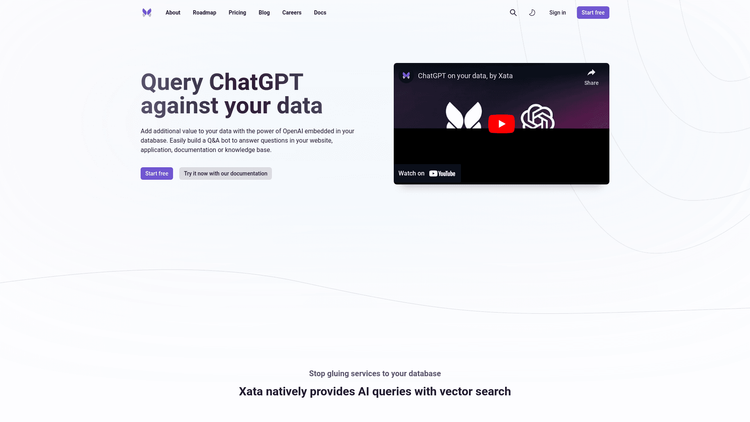What is Xata?
Xata is an innovative service that enables users to effectively leverage the power of OpenAI by integrating it directly into their databases. By doing so, one can effortlessly add significant value to their data. This advanced feature facilitates the development of smart Q&A bots that can respond to queries in websites, applications, knowledge bases, and documentation. Furthermore, Xata boasts a native AI query with vector search capability, which simplifies the process of creating AI-oriented questions and answers within the database.
The platform is designed for complete customization, offering comprehensive control to the user to tune the AI according to their data's requirements. Speed is of the essence in today's fast-paced digital world, and Xata keeps up by providing a native full-text or vector search that returns results promptly. This feature is particularly beneficial in managing large volumes of data efficiently.
An appealing aspect of Xata for many users is its generous free tier. This package includes 750K records and 15GB storage and includes OpenAI API calls. Hence, Xata not only aids in conducting intelligent data operations but also accommodates the financial considerations of users. It is a solution that balances overall functionality, customization rights, and economic aspects to deliver top-notch AI data integration.
How to Use Xata: Step-by-Step Guide to Accessing the Tool
Using Xata is a straightforward process. The first step involves loading the content. This could be achieved by importing from a CSV file or using Javascript, Typescript, or Python SDKs to populate the data. The platform also includes a spreadsheet-like user interface that makes reviewing and editing the database a breeze.
- Load the content: You can import your data from a CSV or use Xata's Javascript, Typescript, or Python SDKs to populate your database. The UI also offers a spreadsheet-like feature for easy data review and edition.
- Call the API: You make a simple API call, and ChatGPT starts answering questions using your data as context. You can also provide custom rules to refine your results.
- Tune the results: To get the best results, you can use the UI to configure column weights and value boosters, ensuring optimized search experiences.
These three steps serve as a simple guide to utilizing Xata efficiently. However, for specialized tasks or further fine-tuning, users have the freedom to make adjustments that suit their individual requirements.
Xata Use Cases
Xata is not only a versatile tool for integrating AI into your data, but it also has a wide range of applications. By embedding AI into your database, you can easily construct a Q&A bot that can answer inquiries on your website, application, or any documentation. This makes Xata an excellent tool for creating intuitive and interactive user experiences.
Storing, sorting, and accessing large amounts of data can be time-consuming and inefficient without the right tools. Xata addresses this issue with its speedy search feature that carries out vector or full-text searches swiftly. This functionality makes Xata ideal for managing substantial amounts of data.
Lastly, Xata's tuneability makes it a reliable tool for detailed data work. By tweaking the settings and adjusting the controls, you can optimize the AI to deliver the best results specific to your data. This makes Xata a perfect partner for those looking for precise and efficient data management.
